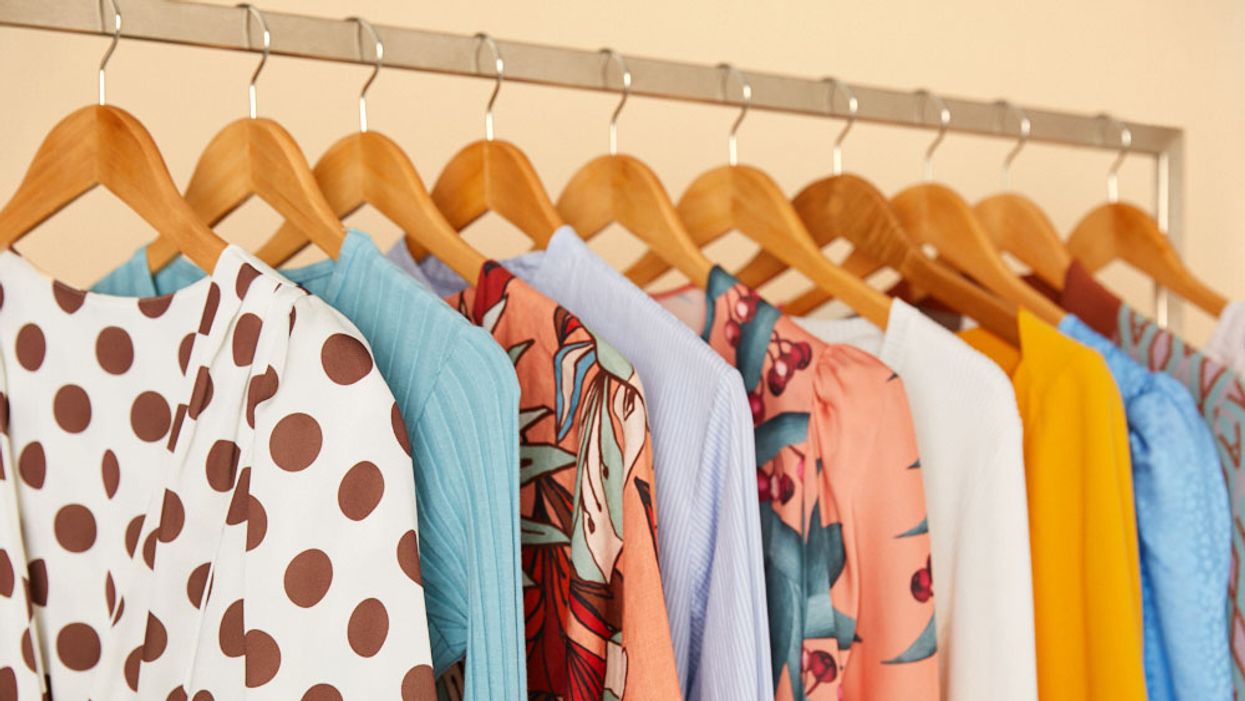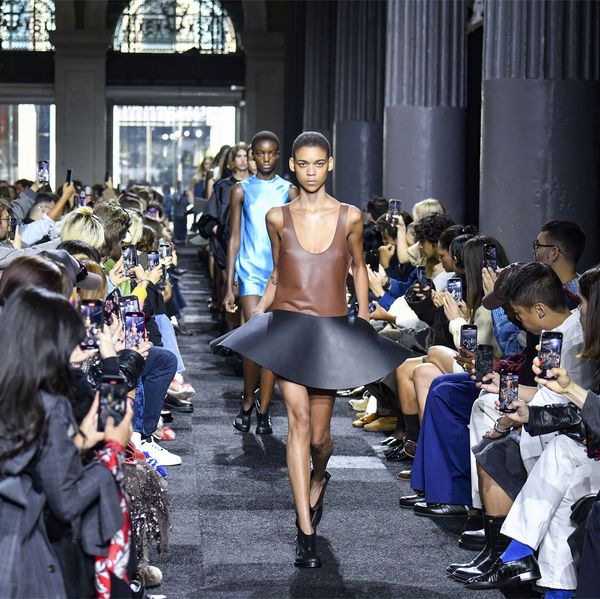Fashion
Resale Isn’t Just for Collectors Anymore—It’s for Brands, Too
The next step in fashion democracy.

09 October, 2020
10 November, 2021
Fashion is fueled by newness. The entire system is set up to convince consumers of their need to own the latest and greatest, effectively rendering their current wardrobe useless. But now it’s 2020. With more knowledge comes more power as shoppers realize that sustainable alternatives—resale specifically—can provide new avenues for purchases just as fashionable. You would think brands, especially those who are churning out collection after collection, would fight against the notion, but guess what? Gucci just signed on.
As of October 5th, also known as National Consignment Day, Gucci and TheRealReal, both major power players in the luxury space, have teamed up to launch an online shop together. The Gucci x TRR shop features a curated edit of items from handbags to shoes to clothes sourced both from sellers and directly from Gucci (samples that may have been used for campaigns or editorially).
As of October 5th, also known as National Consignment Day, Gucci and TheRealReal, both major power players in the luxury space, have teamed up to launch an online shop together. The Gucci x TRR shop features a curated edit of items from handbags to shoes to clothes sourced both from sellers and directly from Gucci (samples that may have been used for campaigns or editorially).
 Photo: Courtesy of The RealReal
Photo: Courtesy of The RealReal
A lot of the marketing emphasis for the collaboration is placed on sustainability. TRR released the statistic that consignment of women’s and men’s Gucci clothing on TheRealReal has already saved 230 metric tons of carbon and 10+ million liters of water, as compared to the environmental costs of manufacturing those items for the first time. The partnership has even committed to combatting deforestation, offsetting their carbon footprint by planting a tree via One Tree Planted every time a Gucci item is bought or consigned on The RealReal.
“It’s no secret that sustainability is a value prized by many millennials and Gen Z consumers, and that’s where we’re seeing the greatest growth in Gucci demand on our site,” explains Allison Sommer, senior director of strategic initiatives at The RealReal. “Forging a direct partnership with us also provides a path for Gucci to engage and build loyalty with younger demographics.”
“It’s no secret that sustainability is a value prized by many millennials and Gen Z consumers, and that’s where we’re seeing the greatest growth in Gucci demand on our site,” explains Allison Sommer, senior director of strategic initiatives at The RealReal. “Forging a direct partnership with us also provides a path for Gucci to engage and build loyalty with younger demographics.”
“It’s no secret that sustainability is a value prized by many millennials and Gen Z consumers.”
That savvy market segment is a target for many luxury fashion brands. Perhaps that’s why Rodarte, Anna Sui, Eckhaus Latta, Richard Quinn, Miaou, and No Sesso count self-dubbed “peer-to-peer marketplace” Depop as a partner. “The existing Depop community is made up of 22+ million users, 90 percent of whom are under the age of 26,” says Steve Dool, head of designer partnerships.
The virtual platform where just about anyone can create an account to sell shoes, clothing, accessories, and more is not solely about selling secondhand stuff anymore. For example, Anna Sui is using Depop for archival runway pieces to promote “alongside the Gen Z sellers who are inspired by her design legacy. That helped us provide context and education for younger sellers, not to mention making those covetable, hard-to-find pieces available to buy,” explains Dool.
The virtual platform where just about anyone can create an account to sell shoes, clothing, accessories, and more is not solely about selling secondhand stuff anymore. For example, Anna Sui is using Depop for archival runway pieces to promote “alongside the Gen Z sellers who are inspired by her design legacy. That helped us provide context and education for younger sellers, not to mention making those covetable, hard-to-find pieces available to buy,” explains Dool.
“The existing Depop community is made up of 22+ million users, 90 percent of whom are under the age of 26.”
Depop is an extremely interactive platform that sits somewhere between third-party retail and direct-to-consumer. “It’s democratic in nature; an individual seller and an established fashion powerhouse both have the same features available when setting up their shops,” says Dool. Consumers can DM, follow, comment; they can engage with the brand in a more organic fashion than they are sometimes able to via other channels.
 Photo: Courtesy of Rent the Runway
Photo: Courtesy of Rent the Runway
“In the beginning, we help brands curate the inventory in their Depop shops to focus on items we know our community wants,” says Dool, “but by interacting with our users, brands quickly discover what the Depop segment of their consumer base wants.” Rodarte attracted their young consumers with their accessibly priced Rodarte collection originally launched in 2008. Now they have their consumers’ attention and can be more experimental. “Once a brand engages with the community and builds up a following on Depop, there are opportunities to expand their offering, too.”
Targeting a new consumer segment also means a second chance for clothes that didn’t sell out the first time around. Excess inventory is a huge problem in fashion. Retailers place orders very far in advance, and then when something unexpected like COVID-19 hits, they cancel or decrease orders, sticking brands with product they can’t always sell. Resale platforms not only offer alternative channels for revenue, but they can hopefully decrease what ends up in landfills.
Targeting a new consumer segment also means a second chance for clothes that didn’t sell out the first time around. Excess inventory is a huge problem in fashion. Retailers place orders very far in advance, and then when something unexpected like COVID-19 hits, they cancel or decrease orders, sticking brands with product they can’t always sell. Resale platforms not only offer alternative channels for revenue, but they can hopefully decrease what ends up in landfills.
“[Depop] is democratic in nature; an individual seller and an established fashion powerhouse both have the same features available when setting up their shops.”
“A perk of resale is that you have the benefit of shopping sustainably and keeping pieces in circulation, which is incredibly important at a time when one garbage truck’s worth of textiles is landfilled or burned every second,” adds Sommer.
These aren’t the only ones using alternative channels to make sure clothing finds a new home; even rental platforms are jumping on board. Revive by Rent the Runway is a collection of previously rented garments that will be available to shop on online thrift store thredUP. Both brands on their own provide alternative methods to combat the fast-fashion system and are now joining forces.
These aren’t the only ones using alternative channels to make sure clothing finds a new home; even rental platforms are jumping on board. Revive by Rent the Runway is a collection of previously rented garments that will be available to shop on online thrift store thredUP. Both brands on their own provide alternative methods to combat the fast-fashion system and are now joining forces.
“A perk of resale is that you have the benefit of shopping sustainably and keeping pieces in circulation, which is incredibly important at a time when one garbage truck’s worth of textiles is landfilled or burned every second.”
“The clothing industry is the second-largest polluter in the world—second only to oil and gas. Brands like RTR and thredUP lessen the impact fashion has on our environment by contributing to the circular economy,” said Jennifer Hyman, CEO and co-founder of Rent the Runway. The buzzy phrase “democratizing fashion” popped up a time or two in this conversation, as well.
One of Rent the Runway’s claims to fame is accessibility. Renting a designer garment is much more feasible pricewise than purchasing one. On that same train of thought, purchasing a pre-owned (or pre-rented) garment is also a more realistic option than buying from the primary market. For Revive, the average price of the items available is roughly $150—not the typical cost of a designer good.
With regard to the actual garments being sold, each RTR Revive garment has been previously rented, worn, and of course, dry-cleaned. The items’ conditions range from minor imperfections to near perfect condition, with a huge array of brands from Brock Collection to Jason Wu to Tibi. However, at up to 80 percent off the original retail price, minor wear and tear doesn’t sound too bad.
One of Rent the Runway’s claims to fame is accessibility. Renting a designer garment is much more feasible pricewise than purchasing one. On that same train of thought, purchasing a pre-owned (or pre-rented) garment is also a more realistic option than buying from the primary market. For Revive, the average price of the items available is roughly $150—not the typical cost of a designer good.
With regard to the actual garments being sold, each RTR Revive garment has been previously rented, worn, and of course, dry-cleaned. The items’ conditions range from minor imperfections to near perfect condition, with a huge array of brands from Brock Collection to Jason Wu to Tibi. However, at up to 80 percent off the original retail price, minor wear and tear doesn’t sound too bad.
 Photo: Courtesy of Rent the Runway
Photo: Courtesy of Rent the Runway
The resale industry as a whole has experienced a boom in recent years and another one during the pandemic with conscious consumption trending. Not only is it a savvy brand move for all involved parties, but it means something for fashion power players like Gucci and Rent the Runway to put their seal of approval on resale. It changes the connotation of secondhand goods, something that’s been slowly evolving anyway. “Together, we’re shining a global spotlight on resale that we hope will encourage all consumers to support the circular economy and join us in reducing fashion’s carbon footprint,” says Julie Wainwright, founder and CEO of The RealReal.
The glossy stereotype of exclusivity that luxury was built on has lost some of its sheen, especially when finances are strained. These days, accessibility and sustainability, which most of the luxury sector deemed dirty words even 10 years ago, are important elements to consider.
Top photo: Courtesy of Rent the Runway
Want more stories like this?
A Deeper Look at How Men’s and Women’s Fashion Differ
Is an Iconic Print the Next Iteration of a Designer Logo
Is Virtual Reality Fashion’s Next Frontier?
The glossy stereotype of exclusivity that luxury was built on has lost some of its sheen, especially when finances are strained. These days, accessibility and sustainability, which most of the luxury sector deemed dirty words even 10 years ago, are important elements to consider.
Top photo: Courtesy of Rent the Runway
Want more stories like this?
A Deeper Look at How Men’s and Women’s Fashion Differ
Is an Iconic Print the Next Iteration of a Designer Logo
Is Virtual Reality Fashion’s Next Frontier?




